When we last looked at absence at the end of Autumn Term, we found a slight improvement at secondary compared with the previous Autumn, and little to no change at primary. We did note though, that persistent absence among the youngest pupils, those in Reception and Year 1, seemed to have increased a little.
Now that we’ve got data for the whole of Autumn and Spring Terms, we’re going to see whether these patterns held. And with Key Stage 4 exams beginning next week, we’ll also take a closer look at Year 11.
Data
As usual, data for this post comes from our FFT Attendance Tracker schools – around 6,000 primary and 2,500 secondary schools across England.
For this year’s data, we’ll be looking at the period from the beginning of September up until Friday 5th April. Last year had an earlier Easter holiday, so this data ends a week earlier on Friday 29th March.
Weekly absence
We’ll begin by updating our weekly absence chart. Here, we show the average percentage of sessions missed each week this year at primary and secondary (the darker shade), and compare with the equivalent weeks last year (the lighter shade), and with termly pre-pandemic averages (the grey dotted lines).
Overall, at both primary and secondary, weekly absence in Spring Term tended to be lower than the equivalent week last year, typically by around half a percentage point in the first half-term, and around one percentage point in the second.
Absence in the final week of term, however, was unusually high. Breaking the data down by the reasons for absence recorded in schools’ registers – illness, other authorised[1], and unauthorised – we see that this is driven by a spike in “other authorised absence”.
This is due to the relative timing of Eid al-Fitr, which fell during the Easter holidays last year, but during term-time this year. We see a similar spike last year in June in the same week as Eid al-Adha.
Overall sessions missed
Now let’s aggregate these weekly rates across the whole of Autumn and Spring Terms.
At both primary and secondary, absence so far this year has been very slightly lower than the same period last year. This has been driven by a 0.3 percentage point reduction in absence coded as illness, counteracted somewhat by a 0.1 percentage point increase in authorised absences not coded as illness.
Unauthorised absence remains more than double pre-pandemic rates at secondary, though has fallen by around 0.1 percentage points since last year.
Persistent absence by year group
Let’s turn now to persistent absence – the percentage of pupils who have missed at least 10% of sessions. Across Autumn and Spring terms, this is roughly equivalent to between two and a half and three weeks of school.
In all year groups apart from Reception and Year 1, persistent absence either stayed the same or decreased slightly compared with last year. The difference between this year and last year for Reception and Year 1 pupils has decreased slightly since Autumn’s update.
Overall, in our Attendance Tracker primary schools, 15.5% of pupils were persistently absent this year compared with 15.7% last year, and in our secondary schools, it’s 23.6% this year vs 24.6% last year. The relevant pre-pandemic national figures are 8.4% at primary and 12.7% at secondary.
Persistent absence by region
To see whether these same patterns are mirrored across the country, we plot persistent absence by region.
As is the case nationally, almost all regions show a small drop in persistent absence at primary and secondary, with a slightly larger drop at secondary. The exception is London, where persistent absence at both primary and secondary increased by one percentage point (though London remains the region with the lowest persistent absence at secondary).
At secondary, the regions with the highest persistent absence rates last year tended to see larger drops than the regions with the lowest rates. This, combined with rates in London having increased slightly, has narrowed the range between regions to just three percentage points, the same as the range at primary.
Year 11 persistent absence by region and disadvantage
To finish, we’re going to take a closer look at persistent absence in Year 11. Again, we’ll plot persistent absence by region (the top panel) but, this time, we’ll also split it by disadvantage (the bottom two panels).
As usual, we’ll measure disadvantage using the variable “FSM6”, indicating that a pupil has been eligible for free school meals in the last six years. Around 27% of pupils in our Attendance Tracker schools were disadvantaged.
As was the case for all secondary pupils, persistent absence among those in Year 11 fell slightly in all regions apart from London, where it rose (though London again remains the region with the lowest rates).
Changes from last year were also similar for both disadvantaged and non-disadvantaged pupils, with small drops for both groups across all regions apart from London.
The gap in persistent absence between disadvantaged Year 11 pupils and their peers varies substantially by region. In London this year, the gap was around 19 percentage points, compared with 30 percentage points in the South East. This difference is driven by disadvantaged pupils in the South East being much more likely to be persistently absent than disadvantaged pupils in London.
This is not a new phenomenon. Disadvantaged pupils in London had lower persistent absence rates than disadvantaged pupils in other parts of the country before the pandemic too. (In 2018/19, across the whole academic year, 18% of London’s disadvantaged secondary school pupils were persistently absent compared with 26% in other parts of the country). However, with persistent absence rates having increased so much during and after the pandemic, the percentage point differences involved are higher.
Summing up
Overall, the story is a familiar one. Absence seems to have come down a little this year compared with last year, though remains some way above pre-pandemic levels.
The improvements on last year are driven by a small reduction in absence coded as illness-related, though we’re still seeing around 30% more of this type of absence than we were before the pandemic. The biggest difference compared with pre-pandemic is still unauthorised absence at secondary, which remains more than double pre-pandemic rates.
Persistent absence among Year 11 pupils, particularly disadvantaged Year 11 pupils, remains high, though has improved since last year in almost all regions.
Want to stay up-to-date with the latest research from FFT Education Datalab? Sign up to Datalab’s mailing list to get notifications about new blogposts, or to receive the team’s half-termly newsletter.
[1] “Other” is a catch-all category for all forms of authorised absence which aren’t coded as illness-related, for example medical appointments, or “C” coded leaves of absence which may indicate a flexi-schooling arrangement.



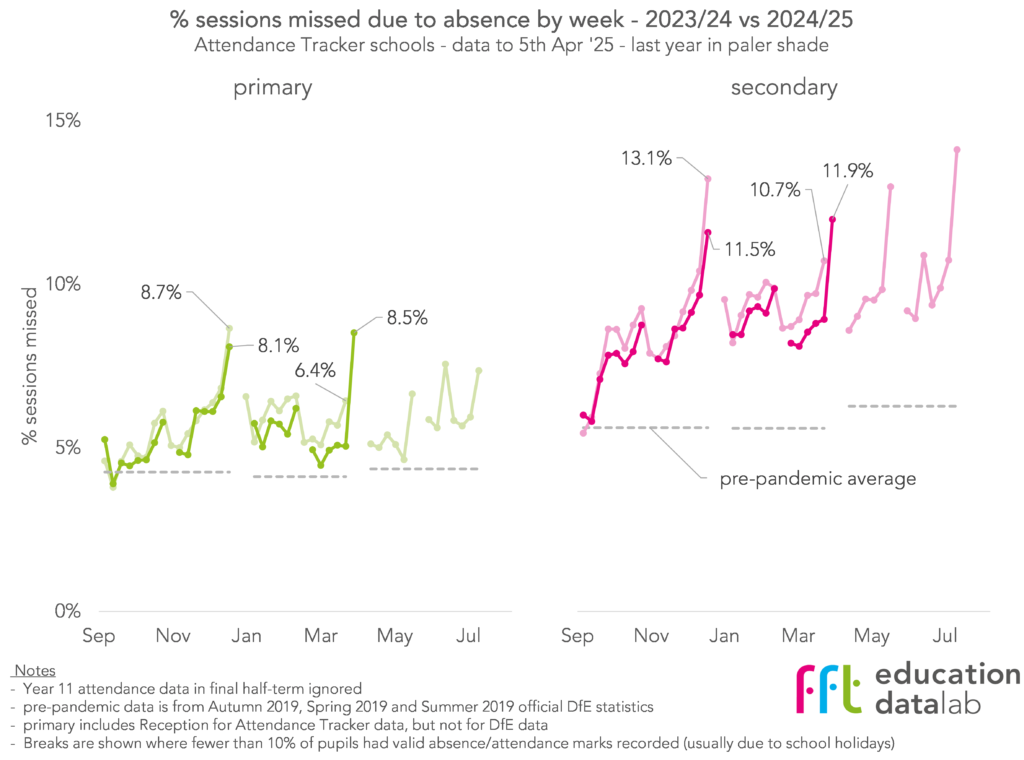
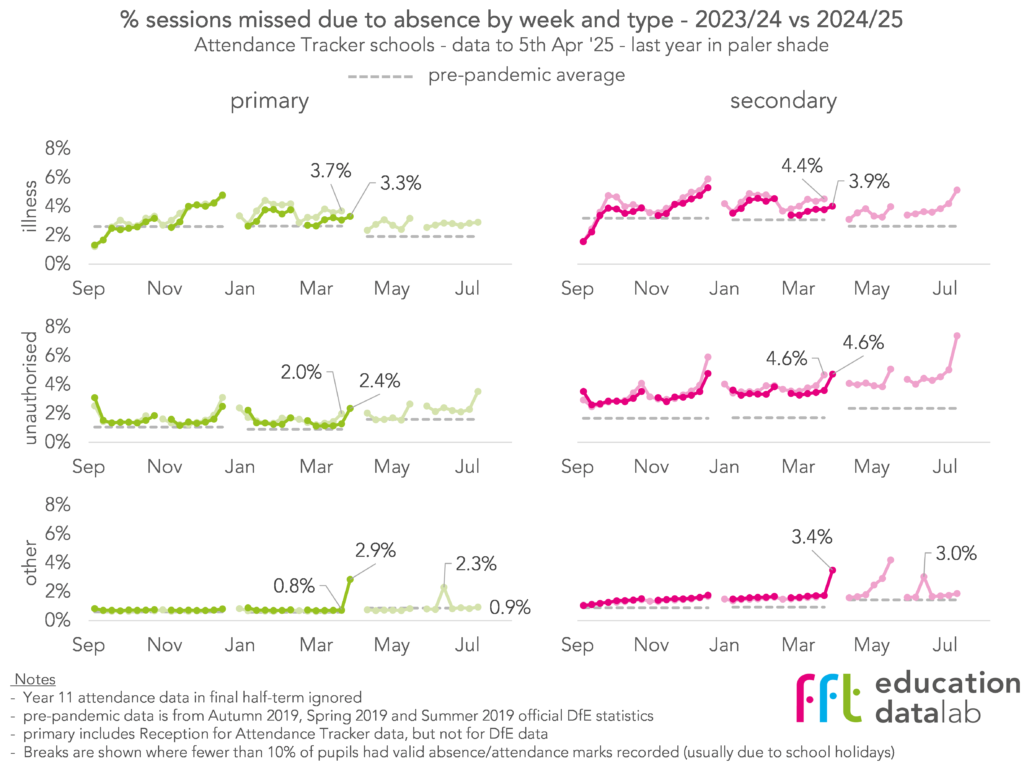
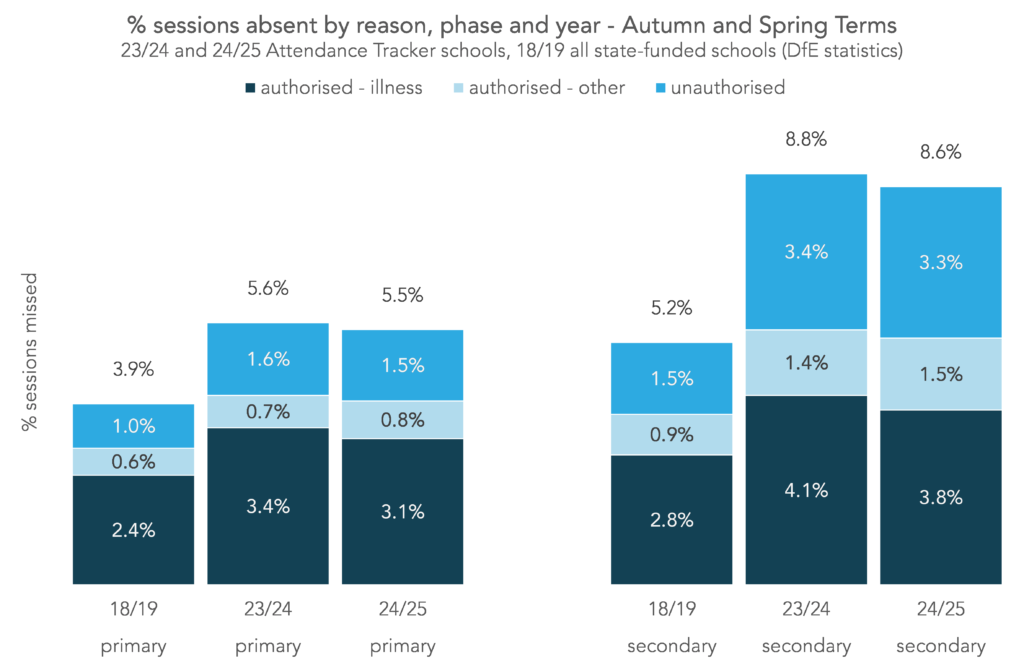
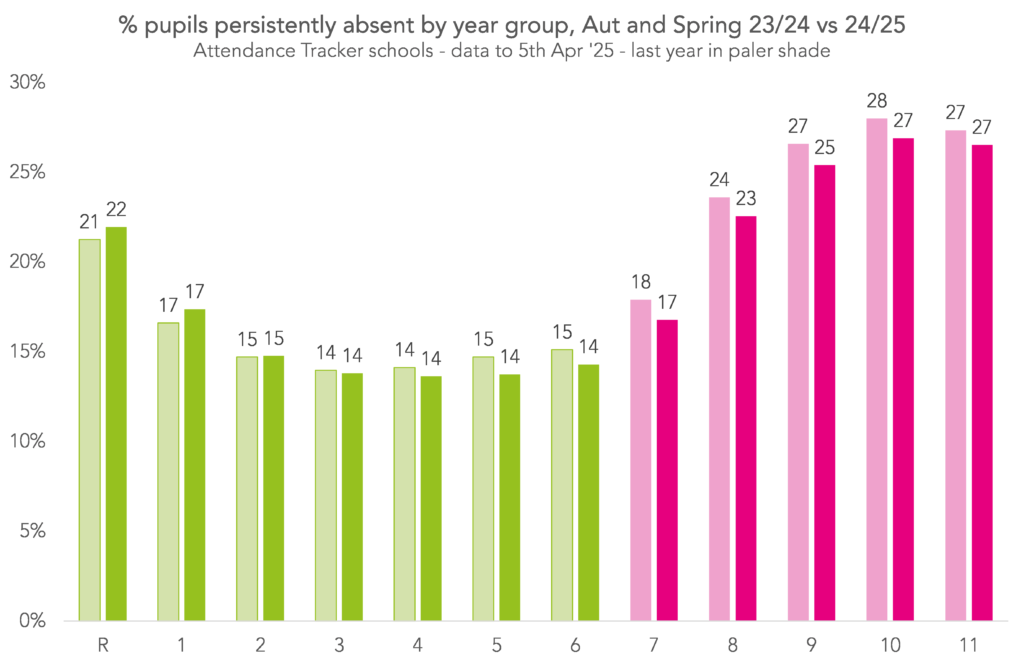
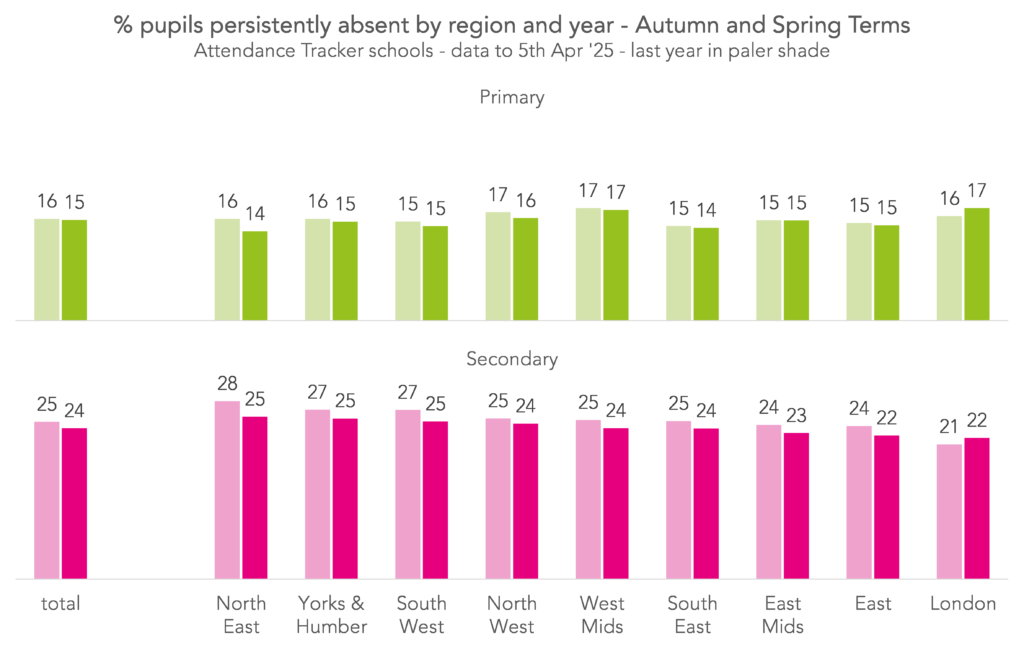
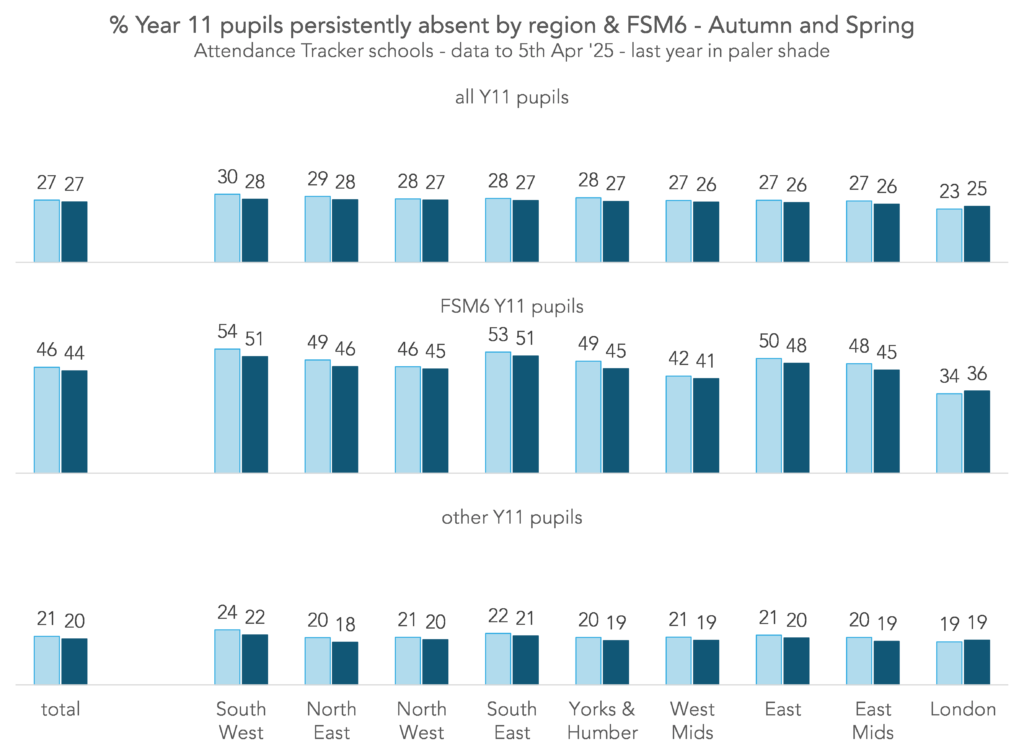
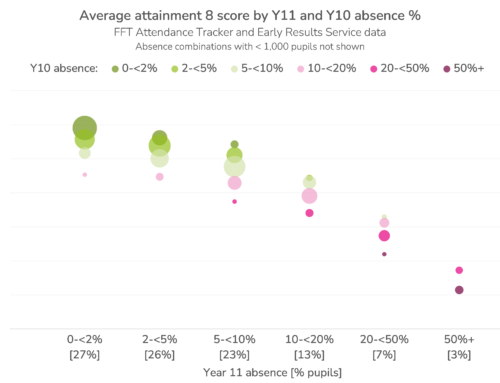
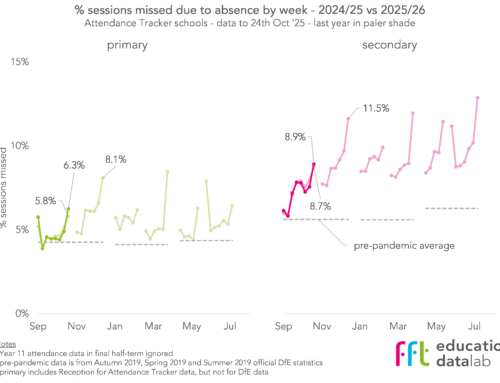
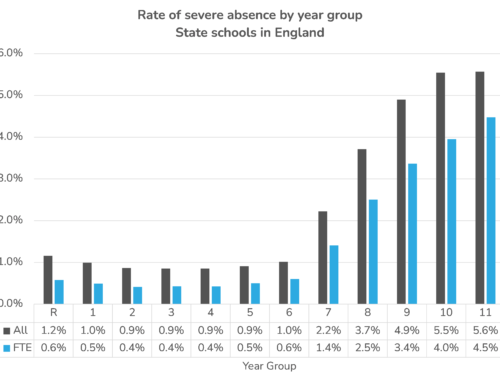
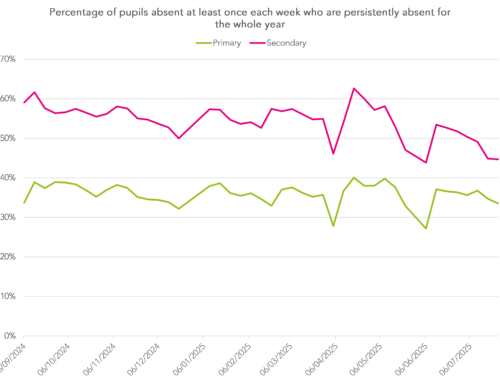
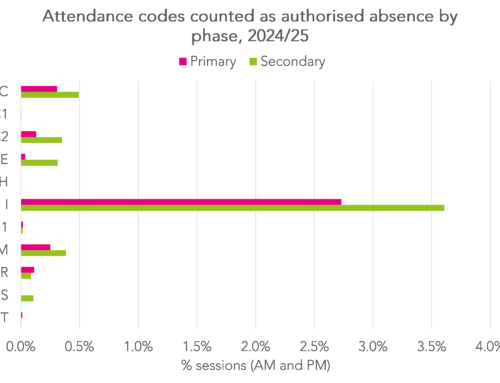
Hi, I can not find the link to download certificates?
Sorry Valerie- not sure what you mean?